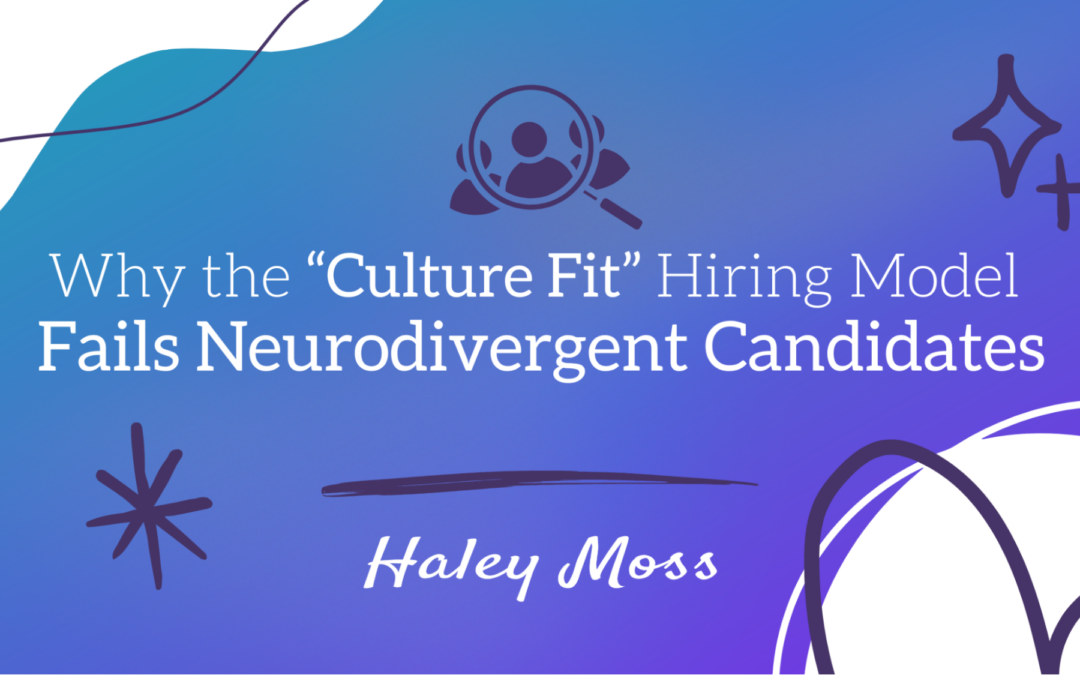There are many strategies for hiring new talent into the workplace, but one of the most essential aspects we must remember is that those strategies need to be open to all.
Talent can be found everywhere within anyone. The specific skills, techniques, education, or experiences you are looking for in a new hire could be in any individual, including a neurodivergent individual. That’s why a “culture fit” hiring model might be holding you back from finding the best talent out there.
It could be time to change your hiring process to include more individuals with the skills necessary to fill the role.
What Is Hiring for “Culture Fit?”
Hiring a culture-fit candidate means looking for a candidate who aligns with the company’s values, beliefs, mission, and behaviors. While it can be essential to find someone who can see the big picture just as well as you do, it can also be the leading cause of unintentional bias in your hiring process.
Alongside a culture fit, there might also be those who hire candidates who align with the existing team’s dynamics, communication styles, and work styles. Once again, hiring for this exclusively can inadvertently cause you to ignore long lists of other potential candidates, especially neurodivergent candidates.
How Does “Culture Fit” Hiring Fail Neurodivergent Candidates?
Hiring with these mindsets can seem like a no-brainer, as you will obviously want someone who will “fit” well with your organization, but often, “fitting in” is not what makes a candidate the perfect option. If you are only looking for an individual who fits in, you are closing the doors to neurodivergent candidates in the process.
Underlying Biases
One of the most significant reasons a “culture fit” hiring model fails neurodivergent candidates is its underlying biases. When employers hire for the best fit, they are ultimately looking for individuals similar to themselves and the other team members.
This will lead them to favor candidates who remind them of themselves, leading to a homogenous workforce. All of this will cause a workforce of very little diversity and innovation as everyone might think and work the same way.
Ignoring Unique Strengths and Skills
Hiring with a “culture fit” model will effectively ignore the unique strengths and skills that neurodivergent candidates possess. One of the most influential benefits of hiring a wide range of talent is the ability to foster multiple perspectives and strengths. However, those benefits are not taken advantage of if that wide range is shrunk. A “culture fit” model would overlook those unique strengths and skills in favor of similarity.
Closes the Doors on Talent
Neurodivergent individuals in the workforce already struggle to find positions that can fit well with their lifestyles, needs, and accommodations. The workforce can already be slim for many of us. Then, if a “culture fit” model is added on top of that, even more doors close for neurodivergent candidates.
Unfortunately, many neurodivergent individuals will work just as hard as neurotypical individuals to grow their education and workforce experience, but when faced with “culture fit” models, they are not considered.
Leans on Conformity
Conformity is one of the most significant factors when it comes to workplace discrimination. Hiring with the mindset of keeping dynamics, work styles, ideas, and values all the same only leads to a workforce built on conformity, effectively leaving out extremely talented candidates simply because they do not fit the model.
What You Can Do as a Leader
As a leader, employer, or business owner, it should be a priority to lead your business toward success and greatness, and that means having a team of individuals who can help you get there. Who you hire matters.
So, you should take the time to ensure your hiring process is not closing the doors to neurodivergent individuals who could be amazing additions to your team simply because you are hiring within a “culture fit” model. Reevaluate your hiring process, get multiple perspectives on how to improve it, and work to create a process that is inclusive to all.
If you have further questions or wish to make your workplace a stronger, more inclusive environment, contact me.

